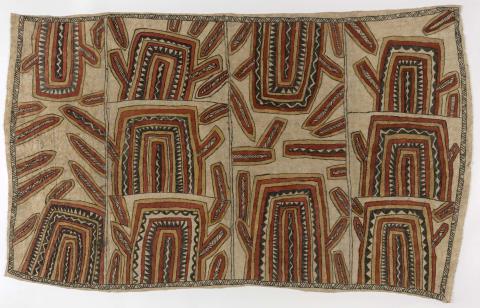Sarah Ugiobari: Tamajai Ohu'o Deb'e (Ancestral tattoo design...)
By Ruth McDougall
March 2017
In many cultures across the Pacific, barkcloth remains one of the most important forms of art making. In most cases, the creation, exchange and display of these cloths is central to the expression of local cultural identity and plays a significant role in the marking of key familial and political events.
The nioge or barkcloth created by Ömie women in Oro Province, Papua New Guinea attests to the extraordinary range of expression available using a restricted colour palette and limited combinations of linear and curvilinear designs over a fibrous surface. Deeply embedded within the creation stories of the Ömie peoples, as well as everyday and ceremonial life, nioge are much more than aesthetic expressions. Like the tattoos once worn by Ömie men, these ‘paper skins’ communicate important information relating to place, resources, custom and people.
A senior woman of the Siorajé clan, Sarah Ugiobari is considered the foremost authority on customary dress. As in other parts of Papua New Guinea, dress — including marks made on the skin — plays a key role in communicating an individual’s affiliations to place and people. During the 1950s, Anglican missionaries established churches and schools in the lower Ömie villages and encouraged villagers to abandon traditional tattoo and initiation practices. Supported by male holders of cultural law, women nioge chiefs subsequently began to record tattoo designs discouraged by the church on their cloth skins.
Sarah Ugiobari has recorded many designs once found on the skin of her late husband. This nioge Tamajai Ohu'o Deb'e (Ancestral tattoo design of the necklace with pandanus fibre string) 2014 documents an ancestral tattoo design the artist learnt from her mother and grandmother. The central arching motif is tamajai, a customary necklace worn in the time of the ancestors. The protuberances are deb'e, a strong fibre, similar to pandanus, used to make the necklace.
With Ugiobari's eyesight failing, the 2016 exhibition of Ugiobari’s nioge paintings is likely to be her last. Ugiobari’s works form an important visual archive of customary tattoo and clan patterns. Bold motifs and colour combined with a dynamic exploration of space animate the painting Tamajai Ohu'o Deb'e (Ancestral tattoo design of the necklace with pandanus fibre string) 2014.
